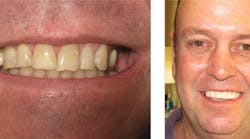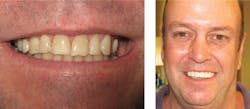by R. Tyler Green, DDS
One of the most commonly overlooked aspects of restorative treatment is the provisional phase, both from the patient's and the clinician's perspective. Traditional temporary fabrication can often be frustrating, time-consuming, and unsatisfactory for the patient. This is a particularly significant concern in multiple-unit restorations. A relatively recent alternative to traditional temporary options provides both patient and clinician with an improved option, both functionally and esthetically.
Assess and repair
Patient "Chef," so nicknamed because he has worked for some of the finest restaurants in our area for many years, contacted our office after a five-year absence complaining about a "loose bridge." Due to insurance changes, Chef had consulted several other dentists over that period. Not having seen him recently, the immediate question centered on what the patient meant by his complaint. Did his case truly involve just the bridge and was the source of his problem related to a loose post or perhaps a periodontally involved tooth?
After the initial radiograph, it was apparent that this case had it all. On a four-unit bridge from teeth Nos. 2 through 5, a post was loose on No. 5 due to gross caries, while the periodontal condition of the tooth was compromised on a long-span bridge. No. 2 was hyper-erupted and the furcation exposed. As is so often the case, circumstance played a role in the patient's immediate treatment needs. He had an important dinner event that same night! In this case, the short-term goal was to stabilize his dentition for this special event, while treatment planning the long-term goal of a stable result to prevent recurrence. After removal, the bridge abutment was thoroughly cleaned of as much decay as possible while maintaining the shape to accept the post again. It only needed to survive the evening.
Upon completion of this first phase of the patient's restoration, long-term treatment options were discussed. After discussion of available options, the placement of an implant-supported bridge was selected. In the meantime, he was adamant about not having a temporary that would cover any area of his palate because he was an extreme gagger.
Maintain
To Patient Chef's great comfort, he was informed of a cosmetic provisional option that would not only replace his bridge when extracted, but would also allow him to have that "white smile" he has always wanted for the duration of healing.
Snap-On Smile, fabricated in acetyl resin, is a removable, completely tooth-borne cosmetic temporary that can reproduce the shade and, to some extent, the ideal shape of the planned or proposed permanent veneers or crowns. One of its most significant benefits is that it is removable and, therefore, does not affect the underlying teeth. This proved to be just what the patient wanted. A great degree of lubrication was applied to the recently cemented bridge, providing, in effect, a good stress test. Impressions were then taken, including a CR bite as well as a maximum intercuspation bite. Full face, profile, arch, and smile photographs were taken and shade A1 was selected by the patient for the shared objective of an ideal smile.
Restore
Patient Chef's Snap-On Smile delivery had been coordinated to arrive the day before so that the appliance would be ready for delivery upon completion of the extraction and placement of implants. Throughout the course of his implant surgery and final placement, Snap-On Smile was Patient Chef's provisional appliance. As a precursor to his final restorations, Snap-On Smile promised great things to come.
Now Chef's cooking
With the option of Snap-On Smile, the clinician can provide patients not only with a great temporary smile, particularly in emergency cases, but also a very real experience of future treatment possibilities. Snap-On Smile is an effective provisional consideration as an ingredient in a smile recipe for the restorative process.
R. Tyler Green, DDS, has been running a successful private practice in Conroe, Texas, for the past 15 years. He has been invited to speak around the world and frequently provides lectures on magnification and the adoption and integration of adjunctive technologies to improve the oral health-care industry.







